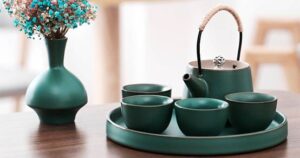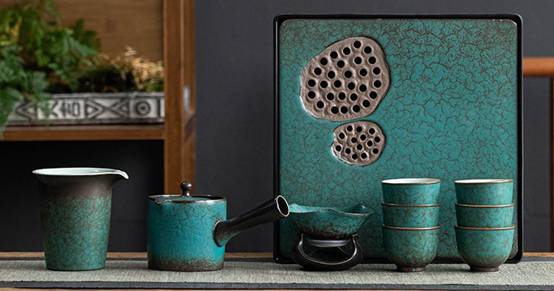Introduction
In the heart of Japanese culture lies a profound appreciation for tea, an art form steeped in history and ritual. For a curated selection of modern Japanese tea sets, visit www.teasetbox.com.While traditional Japanese tea sets have long been cherished for their intricate designs and cultural significance, a new wave of modern tea sets is gaining popularity, reflecting contemporary aesthetics and sensibilities. This evolution showcases a seamless blend of functionality and artistic expression, captivating both seasoned tea enthusiasts and newcomers alike.
Modern Japanese tea sets encapsulate a philosophy that prioritizes minimalism, sustainability, and innovation—all principles deeply rooted in Japanese tradition. As we delve into the world of contemporary tea sets, we will discover how designers are forging new paths while respecting the rich heritage that defines Japanese tea culture. From unique materials to striking designs, this exploration will unveil the beauty and complexity of modern tea sets, their impact on today’s tea-drinking experience, and how they embody a perfect harmony between art and daily life.
Historical Context of Japanese Tea Sets
The history of Japanese tea sets is deeply intertwined with the evolution of tea culture in Japan itself. Tea was introduced to Japan in the early 9th century, primarily by Buddhist monks who had traveled to China. Initially, tea consumption was limited to the elite and religious circles, with the beverage becoming popular during the Kamakura period (1185-1333). As tea gained popularity, the development of tea preparation methods and the tools used in this ritual began to evolve, paving the way for the creation of beautiful tea sets.
During the Muromachi period (1336-1573), the Japanese tea ceremony, or “chanoyu,” began to take shape under the influence of Zen Buddhism. This period emphasized simplicity, tranquility, and an appreciation of nature, translating into the design of tea sets. The aesthetics of simplicity and imperfection, known as “wabi-sabi,” became foundational principles, leading to the creation of rustic tea ware made from earthen materials, such as rustic pottery and raw clay.
The Azuchi-Momoyama period (1573-1603) witnessed a surge in the popularity of tea drinking among the samurai class and the burgeoning merchant class. As tea culture spread, so did the demand for exquisite tea sets. This period marked the emergence of refined ceramics, particularly in regions such as Mino, Kutani, and Hagi. Artisans began to develop unique glazes and styles, each reflecting local craftsmanship and heritage.
With the Edo period (1603-1868), tea sets became more accessible to the general public, leading to a proliferation of styles and designs. These tea sets began to incorporate ornamental elements, such as elaborate motifs and intricate painting, showcasing the skills of local craftsmen. The concept of tea drinking transitioned from a strictly ritualistic practice to a social one, leading to diverse tea ware that catered to different occasions and tastes.
Entering the modern era, after Japan’s Meiji Restoration in the late 19th century, the industrial revolution altered the production of tea sets. Western influences began to merge with traditional designs, and new materials like porcelain became widely used. During this time, the appreciation for fine craftsmanship and high-quality materials remained, albeit with a new, more diverse array of styles that catered to a growing international audience.
Today, the legacy of traditional Japanese tea sets continues to inform modern designs. Contemporary artisans and designers draw inspiration from historical practices while embracing new technologies and sustainable materials. This harmonious blend of the past and present not only preserves the cultural significance of tea but also adapts it for future generations.
Elements of Contemporary Japanese Tea Set Designs
Contemporary Japanese tea set designs are a fascinating blend of traditional aesthetics, innovative materials, and minimalist philosophy. The art of tea drinking has not only been preserved but has also evolved to resonate with modern sensibilities. Here are some key elements that define contemporary Japanese tea set designs:
- Minimalist Aesthetics
One of the most distinctive traits of modern Japanese tea sets is their emphasis on minimalism. Inspired by Zen philosophy, these designs often feature clean lines, understated forms, and a focus on functional beauty. Instead of ostentation, contemporary tea sets prioritize simplicity, allowing the quality of the materials and craftsmanship to take center stage. This allows users to appreciate the tea itself and creates a sense of tranquility during the tea-drinking experience.
- Natural Materials
Modern artisans often choose materials that highlight the natural beauty of their origins. Stoneware, porcelain, and handcrafted ceramics are common choices, but there is also a growing trend toward eco-friendly materials. The use of local clay and glazes not only supports sustainability but also connects the user with the environment. Some designers are even incorporating recycled materials and innovative sustainable practices, further embodying a commitment to both artistry and ecological responsibility.
- Functional Design
Functionality remains a core principle of contemporary Japanese tea sets. Each piece is designed with a purpose in mind, from teapots to teacups, ensuring that they serve both aesthetic and practical needs. Many modern sets are crafted to enhance different types of tea experiences, accommodating various brewing techniques and serving styles. Ergonomics are taken into account, with handles designed for comfort and usability, reflecting a deep understanding of the user’s needs.
- Color and Texture
Contemporary designers experiment with colors and textures that evoke the beauty of nature. Surfaces may be left unglazed to showcase the raw texture of the clay, while others may feature subtle, earthy tones reminiscent of the Japanese landscape. Bright pops of color may also be included, influenced by global taste trends, creating a vibrant contrast against neutral backgrounds. This thoughtful interplay of color and texture contributes to a visual experience that is both modern and deeply rooted in nature.
- Cultural References
Despite their modern adaptations, contemporary tea sets often pay homage to traditional Japanese crafts, embodying cultural elements within their designs. Patterns inspired by nature, like cherry blossoms and bamboo, can often be found, while structural forms may recall ancient techniques. These references serve as a bridge between past and present, allowing modern tea drinkers to connect with Japan’s rich cultural heritage.
- Personalization and Customization
In the contemporary market, there is an increasing demand for personalized tea sets. Designers are responding to this trend by offering customizable options, allowing patrons to choose colors, patterns, and even the shapes of the items within a set. This level of personalization adds a layer of intimacy to the tea-drinking experience, making it more meaningful for the individual.
Prominent Designers and Brands in Contemporary Japanese Tea Ware
As the realm of contemporary Japanese tea ware evolves, several designers and brands have emerged as prominent figures, each bringing their unique vision and artistry to this age-old tradition. Below, we explore some of these influential creators who are shaping the landscape of modern tea sets in Japan.
- Kinto
Kinto is renowned for its commitment to simple yet elegant design that harmonizes function with aesthetics. Founded in 1972, the brand emphasizes creating pieces that enhance the tea drinking experience while being accessible to a global audience. Their tea sets often feature a mix of traditional forms and modern elements, utilizing materials like porcelain and glass. With clean lines and subtle colors, Kinto aims to bring moments of joy in everyday life and is particularly known for its “UNITEA” series, which showcases a seamless blend of functionality and beauty.
- Miyama
Miyama’s work exemplifies the philosophy of “wabi-sabi,” which celebrates the beauty of imperfection and transience. Established in 1957, this brand focuses on handcrafted ceramics that reflect a deep respect for nature and traditional craftsmanship. Each piece is unique, often featuring organic shapes and earthy tones that resonate with the natural landscape of Japan. Their tea sets evoke a sense of calm and mindfulness, encouraging tea drinkers to appreciate the moment and the rituals that accompany it.
- Yōko Kawai
Designer Yōko Kawai is known for her avant-garde approach to traditional tea ware. With a background in masonry and a passion for innovative designs, she combines various materials like stone and glass to create striking tea sets that challenge conventional aesthetics. Her distinctive pieces often incorporate geometric shapes and bold colors, resulting in eye-catching designs that stand out in any setting. Kawai’s work invites users to experience tea in a new light, redefining the boundaries of traditional tea ware.
- Hasami Porcelain
The Hasami region of Japan has a long-standing reputation for quality porcelain, and Hasami Porcelain exemplifies this heritage with a modern twist. This brand utilizes a unique blend of clay and advanced molding techniques to produce minimalist, stackable tea sets that are both practical and visually appealing. Their designs feature subtle hues and simple lines, making them versatile for various dining experiences. Hasami Porcelain emphasizes environmentally friendly practices, ensuring that their beautifully crafted pieces are sustainable as well.
- Kihachi
Kihachi is celebrated for its vibrant and playful designs that merge contemporary art with traditional tea ware aesthetics. Founded by ceramic artist Masanori Tsubaki, the brand draws inspiration from both the natural world and modern visual culture. Kihachi’s tea sets often boast whimsical patterns and bold color schemes that entice the senses and engage the user’s imagination. The brand aims to transform the ritual of tea drinking into an enjoyable and expressive experience, appealing to a younger demographic while honoring traditional methods.

The Role of Minimalism in Japanese Tea Sets
Minimalism is not just an aesthetic choice in Japanese tea sets—it’s a philosophy that resonates deeply with the cultural values of simplicity, mindfulness, and harmony. Rooted in Zen Buddhism, which emphasizes the beauty of uncomplicated forms and the appreciation of the moment, minimalist designs in tea ware serve to enhance the tea-drinking experience, rather than distract from it.
- Simplicity in Form
At the heart of minimalist Japanese tea sets is the principle of simplicity. These designs typically exhibit clean lines, understated colors, and unembellished surfaces. By stripping away excess ornamentation, the focus is directed towards the function of the tea set and the ritual itself. In a minimalist context, each piece serves a purpose—whether it’s the teapot, cups, or even the tea tray—encouraging users to appreciate the essence of tea and its preparation.
- Mindfulness in the Tea Ceremony
The Japanese tea ceremony, or “chanoyu,” is a perfect embodiment of mindfulness. Minimalist tea sets complement this practice by fostering a serene environment where participants can engage fully with the present moment. The elegance of minimalist designs encourages a sense of calm and encourages users to slow down and savor both the tea and the process. Every sip becomes an invitation to reflect, appreciate, and connect.
- Material and Texture
Minimalist Japanese tea sets often feature materials that highlight natural textures, such as clay, porcelain, or stoneware. These materials are chosen not only for their aesthetic qualities but also for their sensory characteristics. A rough, unglazed surface can enhance the tactile experience, drawing the user’s attention to the weight and warmth of the tea set. This connection to the material world emphasizes a respect for nature and sustainability while enhancing the overall sensory experience of drinking tea.
- Versatility in Design
One of the key benefits of minimalist tea sets is their versatility. Their neutral colors and simplistic forms can seamlessly blend into any table setting or style of décor—be it traditional, modern, or eclectic. This adaptability ensures that minimalism appeals to a wide audience, making it an accessible choice for those new to tea rituals or avid collectors looking to expand their collection.
- Encouraging Personal Expression
While minimalist designs might seem rigid, they also provide a blank canvas for personal expression. Users can choose to pair a minimalist tea set with colorful textiles, seasonal floral arrangements, or artisanal sweets, allowing them to create a unique tea experience that reflects their personality and taste. This harmonious balance between simplicity and individuality encourages creativity within the framework of traditional tea practices.
Cultural Significance of Aesthetics in Tea Drinking
The ritual of tea drinking in Japan transcends the mere act of consuming a beverage; it is deeply interwoven with cultural significance and spiritual philosophy. The aesthetics of tea drinking—encompassing the tea set, the environment, and the entire experience—play a pivotal role in enhancing this centuries-old tradition.
- Harmony and Balance
At the heart of Japanese tea culture lies the principle of “Wa,” or harmony. The aesthetic arrangement of tea sets, the selection of tea, and even the act of brewing are all designed to cultivate a harmonious atmosphere. The visual appeal of a well-curated tea set reflects this balance, providing a sense of tranquility and peace. The gentle curves of a teacup, the earthy tones of the ceramics, and the simplicity of the presentation all contribute to an environment that encourages mindfulness and contemplation.
- Connection with Nature
Japanese aesthetics often stem from a deep-rooted reverence for nature, a concept embraced in the practice of tea drinking. The materials used in modern tea sets, such as clay, stone, and bamboo, embody this connection, while their natural textures and earthy colors evoke a sense of the outdoors. A beautifully crafted tea set allows drinkers to appreciate the essence of the material itself, fostering a mindful awareness of the beauty that surrounds us. This interaction with natural elements enhances not only the sensory experience but also the spiritual connection to the world.
- Artistry and Craftsmanship
The creation of a modern Japanese tea set is often the result of a meticulous artistic process, where each piece is handmade and thoughtfully designed. This artisanal approach accents the cultural significance of tea drinking, as it transforms a simple tea set into a work of art. Each piece tells a story, reflecting the skill and vision of the artisan while honoring the traditions that came before. The appreciation of this craftsmanship encourages tea drinkers to cultivate a deeper respect for the art of tea.
- Ritual and Ceremony
The aesthetic aspects of tea drinking are integral to the rituals that accompany the ceremony. The careful presentation of the tea set, the selection of seasonal decorations, and the arrangement of sweets, all contribute to a sense of occasion. When tea is served in an aesthetically pleasing way, it elevates the experience from the ordinary to the extraordinary. This attention to detail instills a sense of reverence and mindfulness, allowing participants to fully engage with the moment.
- Community and Connection
Finally, the aesthetics of tea also enhance social connections. In Japan, tea ceremonies often symbolize friendship, hospitality, and respect. A beautifully presented tea set fosters a welcoming atmosphere, making it easier for hosts to connect with their guests. As they share a cup of tea, the aesthetic qualities of the experience promote a sense of belonging and community, inviting thoughtful conversations and the sharing of stories.

Incorporating Contemporary Tea Sets into Modern Life
In a fast-paced world where connectivity often outweighs tranquility, the timeless ritual of tea drinking serves as a gentle reminder to pause and savor life’s simple pleasures. Contemporary Japanese tea sets have evolved beyond traditional usage; they now seamlessly blend into modern lifestyles, offering elegance, functionality, and a sense of mindful living. Here’s how you can incorporate these beautiful pieces into your everyday routine.
- Elevating Daily Rituals
Incorporating a modern Japanese tea set into your daily life transforms the act of brewing tea from a mundane task into a celebratory ritual. By dedicating specific times for tea, whether during breakfast or as a midday break, you cultivate a moment of mindfulness. The clean lines and artistic designs of contemporary tea sets encourage you to focus on the sensory experience—the aroma of the leaves, the warmth of the teapot, and the delicate flavors of the brew. Consider creating a tea corner in your home where your beloved tea set is on display, inviting you to pause and appreciate the moment.
- Bridging Cultures and Styles
Today’s contemporary Japanese tea sets often reflect a harmonious blend of traditional craftsmanship and modern aesthetics, making them suitable for a variety of interior styles. Whether your decor is minimalist, bohemian, or even industrial, these tea sets can serve as a stunning focal point. For instance, a simple yet elegant teapot paired with minimalist cups can enhance a modern living space, while intricately designed porcelain might resonate within a more eclectic setup. Mixing and matching these contemporary sets with Western tableware can also express your unique taste and cultural appreciation.
- Social Gatherings and Celebrations
Contemporary Japanese tea sets create an inviting ambiance for social gatherings. Hosting a tea party, whether formal or casual, allows friends and family to come together over warm brews and meaningful conversations. The aesthetic appeal of the tea set plays a significant role in setting the tone for the gathering. Offering a selection of teas and seasonal treats, served in your beautiful contemporary set, encourages guests to explore and enjoy the experience shared over tea, deepening connections and creating lasting memories.
- Mindfulness and Personal Reflection
The act of making tea can be meditative, providing a moment of calm in a chaotic world. Incorporating a contemporary Japanese tea set into your personal routine can serve as a daily practice of mindfulness. Consider starting or ending your day with a quiet cup of tea, using this time to reflect, journal, or simply be present in the moment. The beauty of the tea set can inspire a sense of appreciation for the present, reminding you to slow down and connect with your thoughts and feelings.
- Gifting and Celebrating Culture
A modern Japanese tea set makes for an exquisite gift, symbolizing hospitality, care, and an appreciation of culture. Whether for a wedding, housewarming, or a personal celebration, these sets can convey your thoughtful sentiments. Gifting a tea set not only shares the beauty of Japanese aesthetics but can also introduce the recipient to a new ritual, encouraging them to embrace the art of tea drinking in their own lives.
Conclusion
The modern Japanese tea set stands as a testament to the enduring beauty and significance of tea culture in Japan. With a delicate balance of tradition and innovation, these contemporary designs not only reflect aesthetic values but also prioritize functionality and ecological responsibility. The thoughtful integration of colors, textures, and cultural references allows for a unique expression that resonates with both local and global audiences.
As the art of tea continues to evolve, modern Japanese tea sets invite tea enthusiasts to appreciate the ritual of tea drinking in new and exciting ways. Whether you are drawn to the minimalist elegance of a sleek teapot or the intricate details of a hand-painted cup, these tea sets offer more than just vessels for brewing; they stand as artistic expressions and personal stories waiting to be shared.
In a world where personalization and individuality are increasingly prized, the rise of customizable tea sets encourages lovers of tea to forge a deeper connection with their practice. Ultimately, the modern Japanese tea set embodies both a reverence for tradition and a celebration of contemporary artistry, ensuring that the rich heritage of tea culture continues to thrive for generations to come.







